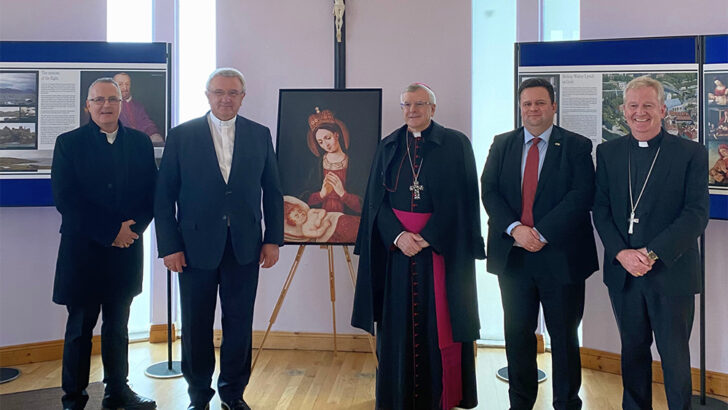Ireland has welcomed the gifting of a painted replica of the sacred Weeping Virgin Mother of Gyõr, presented by His Excellency Bishop András Veres of Gyõr, Hungary, on a recent visit to the island. This gesture reaffirms the deep historical and spiritual bond between Ireland and Hungary – a connection that extends over 350 years.
The painting, often referred to as the ‘Irish Weeping Madonna’ in Hungary, originally came from the Diocese of Clonfert. Its significance dates back to 1650, a time of great upheaval during the Cromwellian Wars, when Ireland was suffering under ruthless colonial rule. At that time, the Irish bishops declared the image ‘Our Lady as Queen and Patroness of Ireland’ during a solemn proclamation. A year later, Bishop Walter Lynch, exiled from Ireland, took the painting to Gyõr for safekeeping, where it remained after his death in 1663. This painting became a symbol of the shared Faith and hardships faced by the Irish people, as it was linked to the experiences of persecution and exile.
Feast
In 1697, on the feast of St Patrick, the Virgin Mary’s image in Gyõr shed tears of blood for three hours. This miraculous event occurred after the imposition of penal laws in Ireland that banned Catholic bishops and priests from the country. The timing of the Virgin’s tears was seen as an expression of solidarity with the suffering Irish, symbolising the deep connection between the two countries, despite their geographical distance.
A series of events were recently organised to commemorate this bond, including the private reception on September 19 and the public exhibition on September 20, highlighting the significance of this shared history. The climax of the celebrations was the unveiling of the replica of the Weeping Virgin at the Cathedral of Our Lady Assumed into Heaven and St Nicholas in Galway.
One cannot overlook the historical parallels that have drawn Hungary and Ireland together. Both nations endured centuries of foreign domination. During this time their cultural and religious identities were systematically suppressed. For Hungary, 1541 marked the fall of Buda -Hungarian capital- to the Ottoman Empire, leading to nearly 150 years of Turkish rule. That same year, Ireland saw King Henry VIII declare himself King of Ireland, beginning a prolonged period of English domination that lasted until the 20th century. These countries are rooted in a shared reverence for the Virgin Mary, whose role in both Irish and Hungarian history is deeply intertwined with the struggles and triumphs of both nations.
Refuge
In 1650, when Bishop Walter Lynch fled Ireland with the sacred image, he found refuge in Hungary – a nation that had its own deep devotion to Mary. Hungary’s dedication to the Virgin Mary dates back even further, to 1038, when the country’s first king, St Stephen, consecrated the nation to her protection shortly before his death.
The bond was further reinforced in the 20th century when Ireland offered refuge to Cardinal Jozsef Mindszenty, a prominent Hungarian figure exiled after the Communist takeover. Ireland’s response to Mindszenty’s plight – issuing him a passport within 24 hours – was a gesture of solidarity that echoed Hungary’s earlier protection of Bishop Lynch.
These historical events, tied together by the figure of the Weeping Virgin, highlight the deep, centuries-old connection between Ireland and Hungary. Both nations have found solace and strength in their shared reverence for the Virgin Mary, a bond that transcends borders and time.


 Renata Milán Morales
Renata Milán Morales From left to right: Bishop Michael Duignan of Clonfert and Galway, Bishop András Veres
of Győr, Apostolic Nuncio to Ireland HE Luis Mariano Montemayor, HE Gergely Bánhegyi,
Ambassador of Hungary to Ireland and Auxiliary Bishop of Dublin Paul Dempsey pictured
with a painted replica of the sacred Weeping Virgin Mother of Győr on September 22, after
Holy Mass. Photo: Embassy of Hungary
From left to right: Bishop Michael Duignan of Clonfert and Galway, Bishop András Veres
of Győr, Apostolic Nuncio to Ireland HE Luis Mariano Montemayor, HE Gergely Bánhegyi,
Ambassador of Hungary to Ireland and Auxiliary Bishop of Dublin Paul Dempsey pictured
with a painted replica of the sacred Weeping Virgin Mother of Győr on September 22, after
Holy Mass. Photo: Embassy of Hungary 